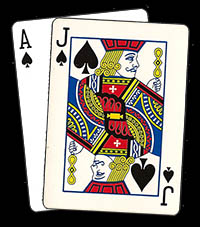
|
| « History of Playing Cards | Early Standards | Gallery of Playing Cards | Card Games Rules | CONTACT |
BlackJack
Like so many other card games, BlackJack can be traced back to the gaming houses of 17th century France. It was know then as “Vingt En Un” or just plain “Twenty-One”. By the late 18th century it had crossed the Atlantic to America where in the chaos of colonialism and immigration, it proceeded without any legal opposition.

The game found its name, "BlackJack" in America. In the saloons and casinos of the New World Twenty One didn't gain much popularity. Gaming houses therefore introduced a practice of paying 10-1 on a Jack and Ace of Spades, together, paired, as your first two cards - A BlackJack! The practice soon proved unprofitable for casinos and was discontinued, but the name, "BlackJack", stuck. Finally, the game met legal opposition in the 19th century, but it survived as an underground enterprise for gangsters and racketeers for many years. It emerges today as one of the most popular table games in the world.
The object of the game is to beat the Dealer with a Total of 21 or less. The Dealer draws on 16 and Stands on 17. The player, on the other hand, may draw as many cards as he likes, so long as his total remains under 21. If it goes past, he busts, and loses his bet.
If the Player’s first two cards are any ‘10’ and any Ace, this is called a “Blackjack” and pays 3-2. If the Player’s Total is equal to the Dealer’s Total, this is called a “Push” and no transaction takes place.
BlackJack has been the subject of many books, and various systems for beating the House. If you want to be a successful BlackJack player there are two things you should know. One is the Basic Strategy and the other is Card Counting.
Basic Strategy
Because each card occurs a particular number of times in the deck and because each one holds a mathematical value, there is actually one true and perfect way to play BlackJack.
All serious players will agree with this premise. Every book written on BlackJack begins with a dissertation on the Basic Strategy, and the importance of mastering its rules. Although Basic Strategy is a mathematical imperative, it's not necessary to understand its maths in order to play the game. All you have to do is know when to stand, hit, or double based on the cards you hold and the one the Dealer is showing. It’s not magic. It’s just the most likely outcomes and best choices over time. If you want to learn how to play BlackJack like a professional, then mastering Basic Strategy is an essential step.
One question often asked is does Basic Strategy give the Player the winning edge over the House? NO! But it maximizes one’s efficiency as a Player by reducing the number of times the Player loses. By playing Basic Strategy you reduce the House’s edge to a bear minimum of just ½%, which isn’t bad if you consider that over a hundred hands between Dealer and Player, that equates to just one hand either way.
By playing Basic Strategy you hold the House’s advantage to virtually even. All you have to do now is make sure the bets you win are higher than the bets you lose.
Basic Strategy » »Card Counting
In Blackjack, as each card is dealt, the deck changes in composition. Thus the odds lilt subtly in favour back and forth between Dealer and Player as the cards are dealt. With card counting we seek to identify those periods along the deal which favour the player, and bet high, and those periods along the deal which favour the Dealer, and bet low. In this way we subtly swing the overall odds in favour of the player as each time the player is confronted with a situation he is more likely to win, and therefore wins more often, he bets higher and his rewards larger, and each time he is confronted with a situation he is more likely to lose, his bets are lower and his losses smaller.
In Blackjack, there are two things a Player has the power to make decisions over. One is the way he plays his cards, the other is how much he bets. Well, the Basic Strategy has the card playing sorted out. All we have to do now is turn our attention to betting big when we are going to win, and betting small when we’re going to lose.
In this way, Blackjack becomes more of a game of ‘chip management’, then it does a game of cards. By all means, enjoy yourself, but once you master the Basic Strategy, all that remains then is managing your bets through the fluctuations of the deck.
For all the hype around card counting, just remember that with every publication of books like “Beat the Dealer” (1963) Blackjack has only grown more popular, and the casinos ever richer. But if you’re happy to keep up your defences, minimize your losses and enjoy some social play, then mastering the Basic Strategy and knowing a little about card counting is probably your best option. Either that or just stay away.
Card Counting » »
BlackJack |
||||||||
| BlackJack | ||||||||
| Basic Strategy | ||||||||
| Card Counting | ||||||||
| Strategy Tables | ||||||||
| History of BlackJack | ||||||||
| Legends of BlackJack | ||||||||
| Ken Uston | ||||||||
| ||||||||
| ||||||||
| ||||||||
|
||||||||
|